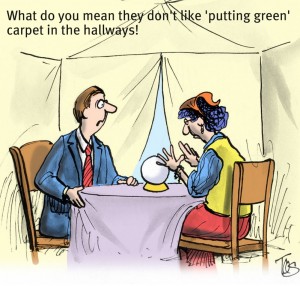 This week I’m going to cover the ups and downs, tips and tricks, insider secrets and need-to-knows of real estate this past year for Portland area buyers, sellers, owners and renters.
This week I’m going to cover the ups and downs, tips and tricks, insider secrets and need-to-knows of real estate this past year for Portland area buyers, sellers, owners and renters.
2011 was a tough year for home sellers in Portland – or at least, for those home sellers who were not in the know about things they can do, big and small, to get what they need despite the scary market climate. So lets go over some seller tips that can help all sellers have success in 2012. This first list runs down the top things that sellers do that send buyers running. If you plan to sell in 2012 or ever, take heed of these suggestions and make sure you are not one of the offenders.
1. Seller-guided home tour. I know you think you’re being helpful, walking the buyer through your home and pointing out the hand sewn drapes you made, the spotless turquoise shag carpet or all of your son’s paintings that cover every inch of your den. However, the buyers might be trying really hard to ignore, minimize or figure out how to undo the very features of your Hillsdale home you hold dear. They also may want or need to have personal space and conversations with their partner or their agent while they’re viewing your home – you being there, especially walking right alongside them while they’re in your home, prevents them from being comfortable about doing this, or discussing all the things they would change if the home were theirs. In my experience, a buyer will just focus on getting out of a house when a seller is home. They will not look at much, will not feel comfortable opening closets or cupboards as they would if you were not present. And when they leave they will not remember the house, but instead the seller and that is not what you want.
What’s a Seller to do? Leave. Let your home be shown vacant, or leave the house when people come to see it. If you need to be there, at least walk outside or go sit at the Starbucks down the way while prospective buyers view your home. If the buyers have questions, their people will contact your people.
2. Dirty, crowded and/or smelly houses. If carpets, bathrooms and kitchens are dirty for a showing, a buyer can only imagine what other major systems are not being tended to. And in sync with the above issue, having a seller present, or worse, having a seller, seller’s children, seller’s grandma, seller’s neighbor and seller’s 4 large dogs present is obviously not a way to get a house sold. So that leaves us with smell. Often you are not aware of any odors in your own home because you live there and are used to it. But if you know the cat has gone to the bathroom on the carpet, I guarantee that that a buyer will smell that and will turn right around and out the door. And for the rest of the day the buyer will refer to your home as the “cat pee house”. Sounds mean or you may think I’m kidding, but I assure you I am not and that I have experienced this countless times. Your job is to get your home noticed – favorably – above the sea of otherPortland homes on the market, many of which are priced very, very low.
What’s a Seller to do? Other than listing your home at a competitive price, the only tool within your control for differentiating your home from all the foreclosures and short sales is to show it in tip-top shape. Pre-pack your place up, getting rid of as many of your personal effects as possible. Do not show it without it being completely cleaned up: no laundry or dishes piled up, countertops freshly washed, smelly dogs ( no judgment – but don’t show your house with pet odors) or litter boxes cleaned and/or out of the house.
3. Irrational seller expectations (i.e., overpricing). Buying a Portland home in today’s market is hard work! On top of all the research and analysis about the market and situating their own lives to be sure they’ll be able to afford the place for 5, 7, 10 years – or longer. Buyers have to work hard to get educated about short sales and foreclosures in the Portland area and often put in many, many offers before they get even a single one accepted. The last thing they want to add to their task lists is trying to argue a seller out of unreasonable expectations or pricing. And, in fact, there are so many other homes on the market, buyers don’t have to do this. Keep in mind that your home is one of many that they have seen in the area and so they are aware and have seen with their own eyes what they can get at a certain price point. When they see a home whose seller is clearly clueless about their home’s value and has priced it sky-high, most often they won’t bother even looking at it. If they love it, they’ll wait for it to sit on the market for awhile, hoping the market will “educate you” into desperation, priming the pump for a later, lowball offer.
What’s a Seller to do? Get real. Did you see a list of comparable properties that have sold recently in your specific area? If yes and you still don’t believe the prices you are seeing then get out there and look at the other properties that are for sale in your area and price range. If your home has much less curb appeal or has an awkward layout or is much less upgraded than the house across the way, don’t list it at the same price and expect it to sell. If you owe more than your home is realistically worth, you may need to reexamine whether you really want or need to sell, or consider a short sale, if you simply have to sell. Don’t be tempted into testing your market with an obviously too-high price, unless you’re prepared to have your home lag on the market and sell for less in the end.
4. Feeling misled. Here’s the deal. You will never trick someone into buying your home. If the listing pics are photo-edited within an inch of their lives, or your home is described as an “approved” short sale when, in fact, the bank approved another offer, now withdrawn, but will require a new offer to go through any sort of approval process (even a truncated one), buyers will learn this information at some point. If your Portland neighborhood is described as funky and vibrant, as code for the fact that your house is under the train tracks and you live in between a wrecking yard and a biker bar, prospects will figure this out. If the detailed information about your home, neighborhood or even transactional position (e.g., short sale status, seller financing, etc.) is misrepresented, the sheer misrepresentation will turn otherwise interested buyers off. If you authorize your agent to “verbally approve” the buyer’s offer, don’t go back the next day demanding an extra $5,000. In cases where the buyer feels misled, whether or not that was your intention, running through the buyer’s mind is this question: If they can’t trust you to be honest about this, how can they trust you to be honest about everything else?
What’s a Seller to do? Buyers rely on sellers to be upfront and honest – so be both. If your home has features or aspects that are often perceived negatively, your home’s listing probably shouldn’t lead with them (like the ad I recently saw with the intro line: “this place is a mess!”), but neither should you go out of your way to slant or skew or spin the facts which will be obvious to anyone who visits your home. Make sure you know what the listing of your home reads like, before it’s published to the web, and that a prospective buyer will not feel misled by it.
5. New, ugly home improvements. Many a buyer has walked into a house that has clearly been remodeled and upgraded in anticipation of the sale, only to have their heart sink with the further realization that the brand-spanking-new kitchen features a countertop made, not of Carerra marble, but brand-new, pink tiles with a kitty cat in the middle of each one (I saw this once, people – no joke). Or the pristine, just-installed carpet in a creamy shade of blue – the buyer’s least favorite color. New home improvements that run totally counter to a buyer’s aesthetics are a big turn-off, because in today’s era of Conspicuous Frugality, buyers can’t justify ripping out expensive, brand new, perfectly functioning things just on the basis of style – especially since they’ll feel like they paid for these things in the price of the home.
What’s a Seller to do? Check in with a local broker or agent before you make a big investment in a pre-sale remodel. They can give you a reality check about the likely return on your investment, and help you prioritize about which projects to do (or not). Instead of spending $40,000 on a new, less-than-attractive kitchen, they might encourage you to update appliances, have the cabinets painted and spend a few grand on your curb appeal. Many times, they will also help you do the work of selecting neutral finishes that will work for the largest possible range of buyer tastes.
6. CRAZY listing photos (or no photos at all). Just when I think I’ve seen it all, I come across a listing where the first picture is the front of the house and 50% of it is blocked by a dumpster or mobile home or one of the rooms is just a bed and a floor completely covered in laundry. Yes moving the broken down mobile home is a pain and cleaning up is hard work but the bottom line is, do you want to sell or not? On the other hand having listing pictures that warp the room in an attempt to make it look bigger is never a good idea. It’s obvious when it’s done and it only irritates buyers. Listing pictures that have put your home in anything but its best, accurate light are a very quick way to ensure that you turn off a huge number of buyers from even coming to see your house! The only bigger buyer turn-off than these bizarre listing pics are listings that have no photos at all; buyers on today’s market see a listing with no pictures and click right on past it, without giving the place a second glance.
What’s a Seller to do? Check yourPortland home’s listing and make sure that the pics represent your home well. More often then not a professional photographer is not necessary. A ready to sell home and a decent camera can do the job.
by Betsy Ballantyne
betsy@betsyballantyne.com



 January 2nd, 2012
January 2nd, 2012  admin
admin  Posted in
Posted in 